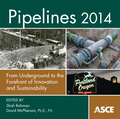Additional Design Considerations for Special Applications of Steel Pipe
Publication: Pipelines 2014: From Underground to the Forefront of Innovation and Sustainability
Abstract
The general design guidelines for steel pipe are given in AWWA Manual M11. The objective of this paper is to recommend a few special design considerations for steel pipe. These conditions are the diameter limitation for bell and spigot gasketed joints, steel selection for seismic considerations, additional measures for low stiffness in situ soils in the pipeline alignment, and required improved toughness properties for pumped mains with large daily pressure fluctuations. Gasketed joints for steel pipe have been used commonly up to 60 in. in diameter under normal operating conditions; larger diameters with special provisions have also been used. The diameter limit depends on many factors, which include maximum internal pressures, pipe stiffness, joint type and tolerances, backfill and in situ soil stiffnesses, and allowable pipe deflections. The performance of the rubber gasketed joints for three southern California pipeline projects with diameters of 89 in., 96 in., and 132 in. will be reviewed along with their original design criteria, so that recommendations can be made. The physical properties of coil or plate steel are critical for the design of steel pipelines subjected to seismic strains caused by movement of nearby faults or anticipated large surface deformations at fault crossings. The strain-based design for such events includes special metallurgical requirements for ductile steel with low yield strength. The metallurgical requirements for the special steel used on two projects will be presented. Backfill and in situ soil stiffnesses are critical for the long-term performance of the buried flexible pipelines. When the in situ soils have poor load-bearing characteristics and their stiffness is less than the required stiffness of the backfill soil, additional design provisions such as the use of soil-cement backfill, increase of the trench width, and evaluation of the combined effect of the backfill and in situ soils should be considered. These recommendations will be discussed, and a test program that includes evaluating soil cement backfill in poor in situ soil will be presented. Steel and weldment material with improved toughness properties are required to avoid long-term fatigue failure on pipelines with large daily cyclical large pressure fluctuations and flow reversal. A discussion on this topic will be presented.
Get full access to this article
View all available purchase options and get full access to this chapter.
Information & Authors
Information
Published In
Copyright
© 2014 American Society of Civil Engineers.
History
Published online: Aug 4, 2014
Authors
Metrics & Citations
Metrics
Citations
Download citation
If you have the appropriate software installed, you can download article citation data to the citation manager of your choice. Simply select your manager software from the list below and click Download.
